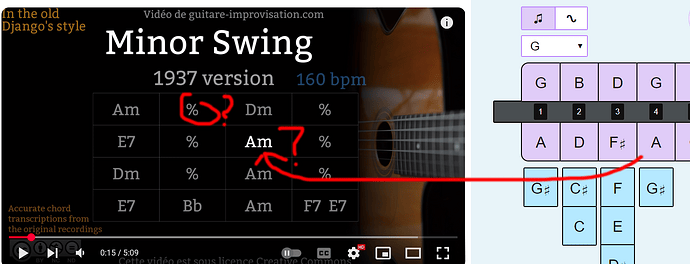Hi all!
Could you folks shed some light on backing tracks, since when trying to use a backing track I realized I had no idea what I was doing.
= what does the “%” symbol mean???
= the video shows the various notes light up like Am. Am I getting the gist that when that lights up I should play the corresponding “A” note on the harmonica?
=The chart also shows notes like F7, E7 - what does the 7 mean? In the case of the G harp (see image to the right), does that mean benduing hole 3 to get F and E?
= overall, please point me in the “right direction” so to speak. Like, I get “Improvising” where you get the initial ‘tune’, then add various differences like vibrato, note length variation, change up one of the notes, play it backwards etc, BUT how on earth do you combine it with the above chart where you need to both do that AND keep up with the current ‘correct’ note, seems like doing 2 different things at once!
thanks in advance!
1 Like
never mind, figured it out (sorta).
The “key” (get it, "key, cause like it’s music!) was to first just to keep playing a single note every 4 beats and just to start off super simple and then very gradually begin adding stuff and begin arpegiating - still need lots of practice though!
Bonus points to those who guess where I learnt the fancy term “arpegiating.”
2 Likes
You can play anything over the backing track that matches the key and tempo. The letters and numerals are the chord progessions. Try ignoring the video just listen and let loose with the music.
Love the terminology. You are so driven it’s inspiring. Please don’t forget to have fun!
3 Likes
The percent sign means “repeat the previous measure.”
The 7 means “add a note on top of the chord, n that is 7 notes away from the lowest note of the chord.”
As for what to play, generally there is what is called “vertical” improvisation and “horizontal” improvisation.
Vertical means that you play notes that match the scale of the chord while the chord is playing.
Horizontal means you mainly play the notes of the key, unless they clash with the chord. In which case you’d alter it or choose a different note.
If that seems overwhelming, no need to sweat it. People take years to be able to know that stuff well enough to do it in context.
To get started, I recommend taking some online classes that focus on music improvisation.
3 Likes
Wanted to post a follow-up, making progress:
**note:**In reality, the backing track was way louder but in the recording it sounds like it’s very quit, so please “imagine” that it’s louder
I’m now able to “fill up” several minutes, mostly repeating scales/minor triads and tying it all together somehow. It’s still not “improvising” per se, but it’s “progress”
- While it’s still not what I’d describe as “good,” the puzzle pieces are slowly falling into place. Currently I’m at around 50% of where I’d ideally wanna be, but it’s the last 10% that will probably take up 90% of the time lol
- Initially, I was getting really out of breath, or so I thought. Most of the notes are “inhale,” and now I very consciously move to the couple of blow notes to be able to exhale. With this “breath economy” it’s now way easier
1 Like

